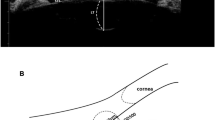Abstract
Purpose
To evaluate the effect of the Valsalva maneuver (VM) on anterior segment parameters and its association with refractive status.
Method
In this prospective study, 120 eyes of 120 subjects were evaluated. Subjects were divided into three groups: myopic (n = 40 patients), hyperopic (n = 40 patients), and emmetropic (control group, n = 40 subjects). The anterior segment parameters, including keratometric, pachymetric, and anterior chamber parameters, were measured using the Sirius System (Costruzione Strumenti Oftalmici, Florence, Italy) before and during VM.
Results
There was no statistically significant difference in corneal parameters including keratometric and pachymetric values at rest or during VM in myopic, hyperopic, and control groups (p > 0.05 for all). In the myopic and control groups, anterior chamber depth, anterior chamber volume (ACV), and anterior chamber angle (ACA) were significantly decreased during VM. In the hyperopic group, only anterior chamber depth was significantly decreased during VM, while ACV and ACA did not significantly change.
Conclusion
The Valsalva maneuver may cause significant narrowing in anterior chamber depth, anterior chamber volume, and anterior chamber angle in the myopic and emmetropic groups, whereas it may affect only anterior chamber depth in the hyperopic group.
Similar content being viewed by others
References
Rafuse PE, Mills DW, Hooper PL, Chang TS, Wolf R (1994) Effects of Valsalva’s manoeuvre on intraocular pressure. Can J Ophthalmol 29:73–76
Liu WC, Lee SM, Graham AD, Lin MC (2011) Effects of eye rubbing and breath holding on corneal biomechanical properties and intraocular pressure. Cornea 30:855–860
Ladjimi A, Zaouali S, Messaoud R et al (2002) Valsalva retinopathy induced by labour. Eur J Ophthalmol 12:336–338
García Fernández M, Navarro JC, Castaño CG (2012) Long-term evolution of Valsalva retinopathy: a case series. J Med Case Rep 6:346
Zebrowska A, Gasior Z, Jastrzebski D (2013) Cardiovascular effects of the Valsalva maneuver during static arm exercise in elite power lifting athletes. Adv Exp Med Biol 755:335–342
Choudhry N, Rao RC (2014) Images in clinical medicine. Valsalva retinopathy. N Engl J Med 20:370
Pekel G, Acer S, Yagci R, Kaya H, Pekel E (2014) Impact of Valsalva maneuver on corneal morphology and anterior chamber parameters. Cornea 33:271–273
Zhang Z, Wang X, Jonas JB et al (2014) Valsalva maneuver, intra-ocular pressure, cerebrospinal fluid pressure, optic disc topography: Beijing intracranial and intra-ocular pressure study. Acta Ophthalmol 92:e475–e480
Wang BS, Xiao L, Liu J, Dong N, Aung T (2012) Dynamic changes in anterior segment morphology during the Valsalva maneuver assessed with ultrasound biomicroscopy. Invest Ophthalmol Vis Sci 53:7286–7289
Bueno-Gimeno I, España-Gregori E, Gene-Sampedro A, Lanzagorta-Aresti A, Piñero-Llorens DP (2014) Relationship among corneal biomechanics, refractive error, and axial length. Optom Vis Sci 91:507–513
Wei WB, Xu L, Jonas JB et al (2013) Subfoveal choroidal thickness: the Beijing eye study. Ophthalmology 120:175–180
Xu L, You QS, Jonas JB (2010) Refractive error, ocular and general parameters and ophthalmic diseases. The Beijing eye study. Graefes Arch Clin Exp Ophthalmol 248:721–729
Buckhurst H, Gilmartin B, Cubbidge RP, Nagra M, Logan NS (2013) Ocular biometric correlates of ciliary muscle thickness in human. Myopia. Ophthalmic Physiol Opt 33:294–304
Mete A, Kimyon S, Uzun I, Kara N (2014) Effects of Valsalva maneuver on ocular biometric parameters: optical low-coherence reflectometry biometer study. Semin Ophthalmol 20:1–4
Falcão M, Vieira M, Brito P, Rocha-Sousa A, Brandão EM, Falcão-Reis FM (2012) Spectral-domain optical coherence tomography of the choroid during Valsalva maneuver. Am J Ophthalmol 154(687–692):e1
Bailey MD, Sinnott LT, Mutti DO (2008) Ciliary body thickness and refractive error in children. Invest Ophthalmol Vis Sci 49:4353–4360
Chang SW, Tsai IL, Hu FR, Lin LL, Shih YF (2001) The cornea in young myopic adults. Br J Ophthalmol 85:916–920
Fledelius HC, Goldschmidt E (2009) Oculometry findings in high myopia at adult age: considerations based on oculometric follow-up data over 28 years in a cohort-based Danish high-myopia series. Acta Ophthalmol 88:472–478
Brody S, Erb C, Veit R, Rau H (1999) Intraocular pressure changes: the influence of psychological stress and the Valsalva maneuver. Biol Psychol 51:43–57
Rosen DA, Johnston VC (1959) Ocular pressure patterns in the Valsalva maneuver. Arch Ophthalmol 62:810–816
Aykan U, Erdurmus M, Yilmaz B, Bilge AH (2010) Intraocular pressure and ocular pulse amplitude variations during the Valsalva maneuver. Graefes Arch Clin Exp Ophthalmol 248:1183–1186
Author information
Authors and Affiliations
Corresponding author
Ethics declarations
Conflicting of interest
The authors declared that they have no conflict of interest.
Rights and permissions
About this article
Cite this article
Kara, N., Kenan, S. Effect of refractive status on Valsalva-induced anterior segment changes. Int Ophthalmol 38, 1205–1210 (2018). https://doi.org/10.1007/s10792-017-0583-6
Received:
Accepted:
Published:
Issue Date:
DOI: https://doi.org/10.1007/s10792-017-0583-6




